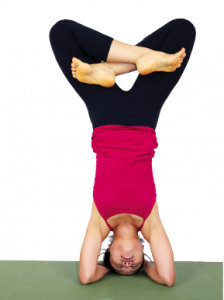Padma Sirsasana is derived from the terms “Padma” or lotus, “sirsa” or head and “asana” or pose.
Inversion poses are beneficial to the practitioner as it send a refreshing boost of energy or prana to the brain. Blood circulation in the head and upper body is improved, therefore reducing nervous disorders and improving and stabilizing one’s emotional state.
In Padma Sirsasana, attention is given to alignment, as being straight is important in keeping the balance while in the pose and avoiding injury.
Asana Overview
Chakra Awareness
Sahasrara Chakra/ Crown
Practice Level
Intermediate
Degree of Difficulty (100 being most difficult)
80
Movement
External Hip Rotation
A movement of turning the thigh or pelvis outward; also known as lateral rotation.
Hip extension
A movement of the hip joint muscles, where the hip joint straightens by being pushed forward (i.e. the thigh or top of the pelvis is brought backward).
Challenges Faced During The Practice
Core muscles strength and body coordination
Awareness and proper body coordination is necessary as the core muscles (abdominals, back and thighs) are unassisted when going into Padma Sirsasana.
Hip Rotation Limitation
As the pose requires the feet to be in Padmasana, any tightness in the hip area will pose as a challenge in going into the pose.
Chances of Injury
Falling forwards or backwards while in the pose
Neck injury
Hip injury while in Padmasana
Contraindications
Existing neck, knee or hip injury
High or low blood pressure
As the top of the head goes upside down, those with irregular blood pressure might feel lightheadedness or nausea while or after doing the pose.
Caution is also advised to pregnant practitioners. Each practitioner has a different preference and comfort level during pregnancy; seek the advice of an experienced teacher and/or an obstetrician before practicing this pose.
Major Muscles Involved
Piriformis
This muscle is located in the gluteus region, close to the sciatic nerve (the largest nerve in the body). The piriformis helps rotate the hip and works with the rotator muscles. It will rotate the thigh while extended and abduct the thigh when flexed.
Gluteus
Located in the buttocks and is said to be strongest muscle in the body. This muscle is responsible for the thigh and hip movements.
Erector Spinae
A muscle group found in the back, which extends the vertebral column in forward and backward bending. This muscle is responsible for returning the vertebral column to the erect position after motion.
Rectus Abdominis
This muscle controls the tilt of the pelvis and curvature of the lower spine. It also tilts the pelvis forward, improving the mechanical positioning of the Erector Spinae.
Best Time to Practice
Morning, when the body is refreshed and energized
Warm-up
 1.Padmasana/ Lotus Pose
1.Padmasana/ Lotus Pose
Sit on the floor, bend the right knee and use the hands to bring the heel close to the pelvis.
Bend the left knee and bring the left leg on top of the right shin, crossing the legs. Aim to bring the left heel to the right pelvic bone.
The feet should comfortably rest on the thighs, close to the hips.
Let the lower back arch slightly. Stay in this pose for a few breaths.
 Steps
Steps
1. Come down to the elbows and knees, toes tucked. Hold the opposite elbow and keep the elbows in place. Interlock the fingers (option to lock the thumbs or keep it open).
 Final Pose
Final Pose
Keeping the shoulders firm, suck the abdomen in and slowly lift the knees away from the body, aligning the knees with the hips.
….more
To read the full article please download our Asana Journal App or purchase Issue 154 Oct 2015.




















 Other
Other